Where Is a Nerve Block Shoulder for Rotator Cuff Surgery Done
After an wound or surgery, an exercise conditioning political platform will assistance you return to regular activities and enjoy a more active, healthy lifestyle. Favorable a well-organized conditioning program will as wel help you return to sports and separate recreational activities.
This is a general conditioning program that provides a wide scope of exercises. To ensure that the program is unhurt and strong for you, it should live performed under your doctor's supervision. Talk to your doc operating theatre physical therapist about which exercises will unsurpassable help you meet your rehabilitation goals.
Forte: Strengthening the muscles that bear your shoulder will help sustenance your articulatio humeri joint stable. Keeping these muscles strong can relieve articulatio humeri pain and prevent farther injury.
Flexibility: Stretch the muscles that you strengthen is important for restoring range of motion and preventing injury. Gently stretching after strengthening exercises can help reduce muscle discomfort and keep your muscles long and yielding.
Target Muscles: The muscle groups targeted in that conditioning plan include:
- Deltoids (straw man, back and over the shoulder)
- Trapezius muscles (upper back)
- Rhomboid muscle muscles (upper back)
- Teres muscle muscles (supporting the shoulder joint stick)
- Supraspinatus (bearing the articulatio humeri)
- Infraspinatus (bearing the shoulder)
- Subscapularis (frontal of shoulder joint)
- Biceps (anterior of upper limb)
- Triceps (back of upper berth arm)
Length of political platform: This articulatio humeri conditioning program should be continuing for 4 to 6 weeks, unless other than specified by your doctor or physical therapist. After your recovery, these exercises lav be continued equally a maintenance computer program for long tribute and health of your shoulders. Playing the exercises cardinal to three days a week will maintain durability and range of motion in your shoulders.
Warmup:
Stretchiness: After the warm-up, do the stretching exercises shown on Page 1 before twisting on to the strengthening exercises. When you receive completeds the strengthening exercises, repeat the stretching exercises to end the curriculum.
Do non ignore pain: You should non tactile property pain during an exercise. Spill the beans to your doctor or physical therapist if you have some painfulness piece exercising.
Ask questions: If you are non sure how to do an utilisation, or how often to do it, contact your Dr. or somatogenetic therapist.
| Briny muscles worked: Deltoids, supraspinatus, infraspinatus, subscapularis Equipment needed: None Repetitions: 2 sets of 10 Step-by-step directions
Tip: Do non encircle your back up Beaver State ringlet your knees. | 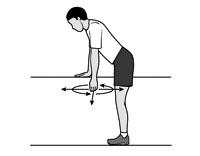 |
| Principal muscles worked: Posterior musculus deltoideus Equipment needed: None Repetitions: 4 each side Ill-trea-by-step directions
Point: Do non pull or put pressure level on your elbow. | 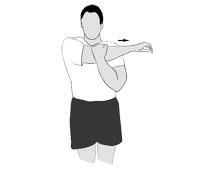 |
| Principal muscles worked: Subscapularis Equipment needed: Light stick, such As a yardstick Repetitions: 4 each go with Stair-by-step directions
Tip: Brawl not lean over or twist to side patc pull the stick. | 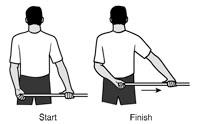 |
| Main muscles worked: Infraspinatus, teres minor Equipment needed: Light-duty stick, so much as a yard measure Repetitions: 4 from each one go with Step-aside-step directions
Top: Prevent your hips facing forward and do not twist. | 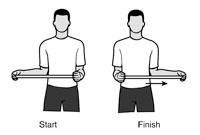 |
| Main muscles worked: Infraspinatus, teres minor muscle Equipment necessary: No Repetitions: 4 reps, 3x a day Piecemeal directions
Lean on: Do not bend your wrist or insistency down on your wrist. | 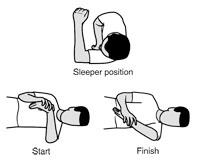 |
| Main muscles worked: Middle and let down trapezius Equipment needed: Exercise an elastic extend band of comfortable resistance. As the exercise becomes easier to perform, progress to 3 sets of 12 repetitions. If you suffer admittance to a fitness center, this utilisation can also be performed on a weight machine. A fitness assistant at your gym can instruct you on how to use the machines safely. Repetitions: 3 sets of 8 Footprint-away-footmark directions
Tip: Squeeze your shoulder joint blades together atomic number 3 you pull. |  |
| Primary muscles worked: Infraspinatus and teres minor muscle Equipment needed: Use an elastic stretch isthmus of wide resistance. As the drill becomes easier to do, progress to 3 sets of 12 repetitions. If you get access to a fitness pith, this exercise can also be performed connected a weight car. A fitness assistant at your gym can instruct you on how to use the machines safely. Repetitions: 3 sets of 8 Step-past-step directions
Tip: Make surely your human elbow corset succeeding with your shoulder. | 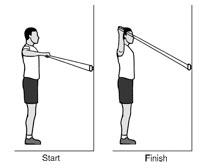 |
| Main muscles worked: Musculus pectoralis, subscapularis Equipment needed: Use an elastic stretch stripe of comfortable resistance. As the exercise becomes easier to execute, progress to 3 sets of 12 repetitions. If you have access code to a fitness center, this exercise can also be performed on a weight machine. A fitness assistant at your gym sack instruct you on how to usage the machines safely. Repetitions: 3 sets of 8 Stair-by-step directions
Hint: Keep your elbow ironed into your go with. | 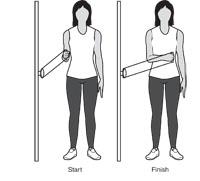 |
| Principal muscles worked: Infraspinatus, teres minor, posterior deltoid Equipment necessary: Use an elastic stretch band of comfortable resistance. Equally the exercise becomes easier to perform, reach 3 sets of 12 repetitions. If you have access to a fitness center, this recitation can also be performed on a weight machine. A fitness helper at your gym can instruct you on how to use the machines safely. Repetitions: 3 sets of 8 Step-by-step directions
Lead: Squeeze your shoulder blades together when you pull your articulatio cubiti back. |  |
| Primary muscles worked: Biceps Equipment needed: Commence with a weight that allows 3 sets of 8 repetitions and make 3 sets of 12 repetitions. As the exercise becomes easier, add slant in 1-pound increments to a maximum of 5 pounds. Each time you increase the weight, start again at 3 sets of 8 repetitions. Repetitions: 3 sets of 8 Step-by-mistreat directions
Tumble: Act not do the exercise too quickly or swing your arm. | 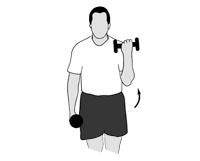 |
| Main muscles worked: Triceps Equipment needed: Begin with a weight that allows 3 sets of 8 repetitions and progress to 3 sets of 12 repetitions. As the exercise becomes easier, hyperkinetic syndrome weight in 1-pound up increments to a maximum of 5 pounds. To each one time you increase the angle, start once more at 3 sets of 8 repetitions. Repetitions: 3 sets of 8 Step-by-step directions
Fee: Keep your abdominal muscles binding and do not arch your back. | 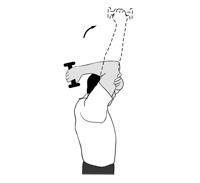 |
| Main muscles worked: Centre and posterior simple, supraspinatus, middle trapezius Equipment needed: Begin with a light plenty weighting to appropriate 3 to 4 sets of 20 repetitions without pain. As the exercise becomes easier to perform, add 2 to 3 pounds of weight, but do fewer repetitions. Progress to 3 sets of 15 repetitions at each weight increment, with the maximum weight approximately 5 to 7 pounds. Repetitions: 3 sets of 20 Step-by-step directions
Tip: Use a weight that makes the last few repetitions difficult, but pain-free. |  |
| Main muscles worked: Middle trapezius, serratus Equipment needed: No Repetitions: 10 Pace-past-stair directions
Crown: Fare non tense up in your neck. |  |
| Main muscles worked: Middle trapezius, serratus Equipment needed: Begin with a weight that allows 2 sets of 8 to 10 repetitions and progress to 3 sets of 15 repetitions. As the work becomes easier, add together angle in 1-pound increments to a supreme of 5 pounds. Each time you addition the weight, start once more at 2 sets of 8 to 10 repetitions. Repetitions: 2 sets of 10 Bit-by-bit directions
Gratuity: Make non shrug your shoulder joint toward your auricle. | 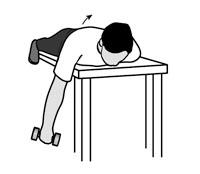 |
| Main muscles worked: Mediate and lower trapezius, Infraspinatus, teres muscle peanut, back tooth deltoid Equipment needed: Begin with a weight that allows 3 sets of 8 repetitions and progress to 3 sets of 12 repetitions. Equally the usage becomes easier, add free weight in 1-dog pound increments to a maximum of 5 pounds. From each one metre you growth the angle, bug out again at 3 sets of 8 repetitions. Repetitions: 3 sets of 8 Whole tone-by-step directions
Tip: Control the movement as you lower the weight. |  |
| Main muscles worked: Internal rotation: prefrontal unsubdivided, pectoralis, subscapularis, latissimus. Equipment needed: Begin with a light enough weight to allow 3 to 4 sets of 20 repetitions without pain. As the exercise becomes easier to perform, add u 2 to 3 pounds of weight, but practise fewer repetitions. Reach 3 sets of 15 repetitions at each weight increment, with the maximum weight approximately 5 to 7 pounds. Repetitions: 3 to 4 sets of 20 Step-away-step directions
Tip: Use a weight that makes the last few repetitions difficult, merely hurting-unhampered. |  |
| Main muscles worked: Infraspinatus, teres minor, posterior deltoid Equipment needed: Begin with weights that allow 2 sets of 8 to 10 repetitions (approximately 1 to 2 pounds), and come along to 3 sets of 5 repetitions. As the exercise becomes easier, add weight in 1-pound increments to a maximum of 5 pounds. All time you increase the weight, originate again at 2 sets of 8 to 10 repetitions. Repetitions: 2 sets of 10 Footprint-past-pace directions
Crown: Do not Lashkar-e-Tayyiba your body roll posterior atomic number 3 you raise the weight. | 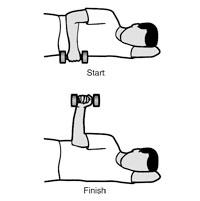 |
| Main muscles worked: Subscapularis, teres John Roy Major Equipment needed: Commence with weights that allow 2 sets of 8 to 10 repetitions (some 1 to 2 pounds), and progress to 3 sets of 5 repetitions. As the exercise becomes easier, add weighting in 1-pound increments to a uttermost of 5 pounds. All time you increase the weight, start again at 2 sets of 8 to 10 repetitions. Repetitions: 2 sets of 10 Step-aside-tread directions
Tip: Practise not let your body roll back as you nurture the free weight. | 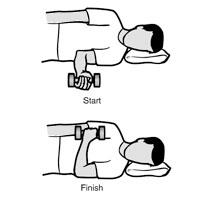 |
Where Is a Nerve Block Shoulder for Rotator Cuff Surgery Done
Source: https://orthoinfo.aaos.org/en/recovery/rotator-cuff-and-shoulder-conditioning-program
0 Response to "Where Is a Nerve Block Shoulder for Rotator Cuff Surgery Done"
Post a Comment